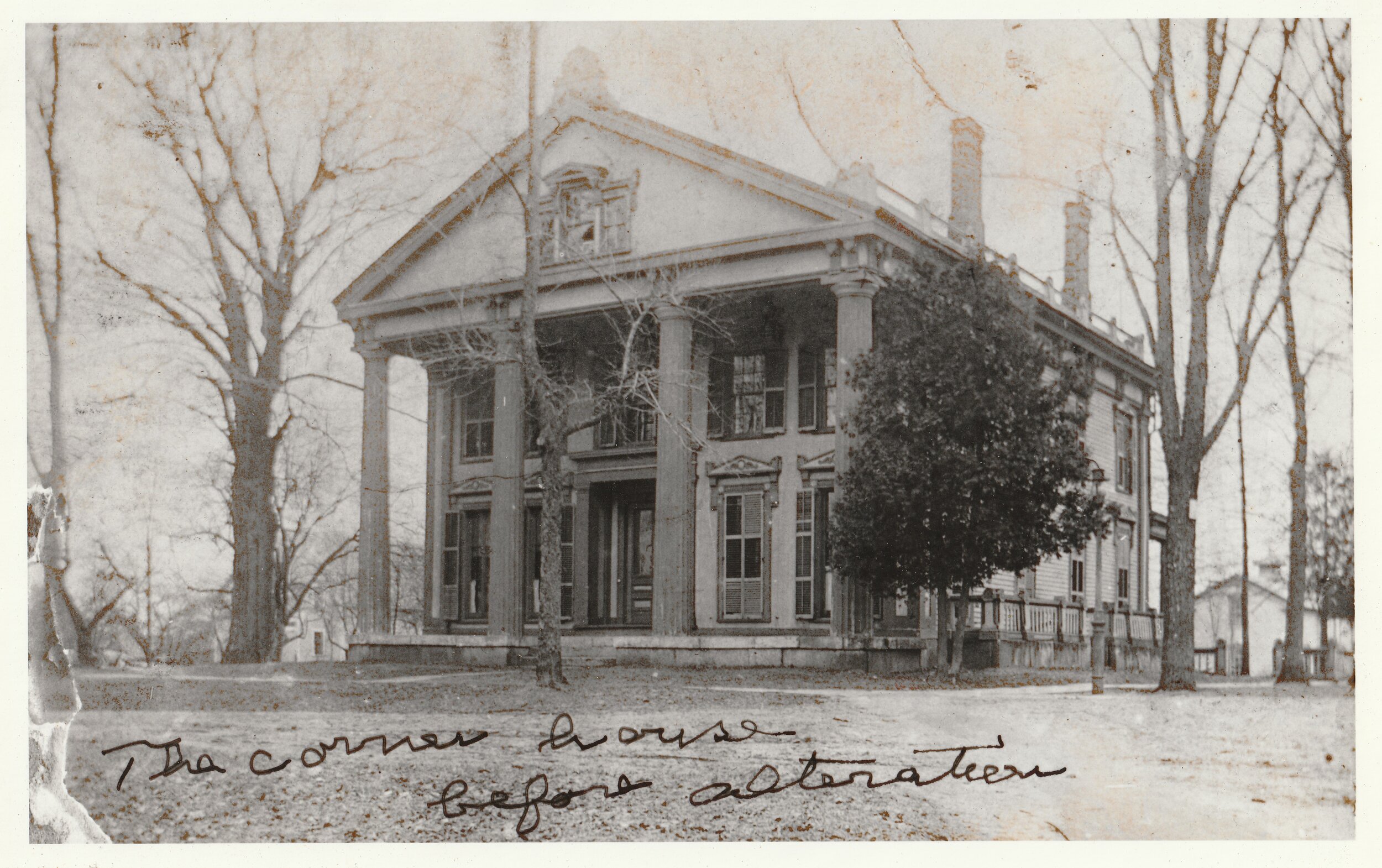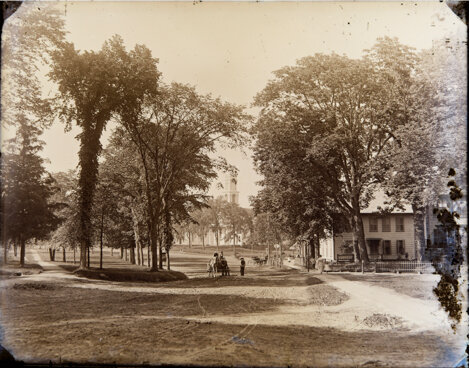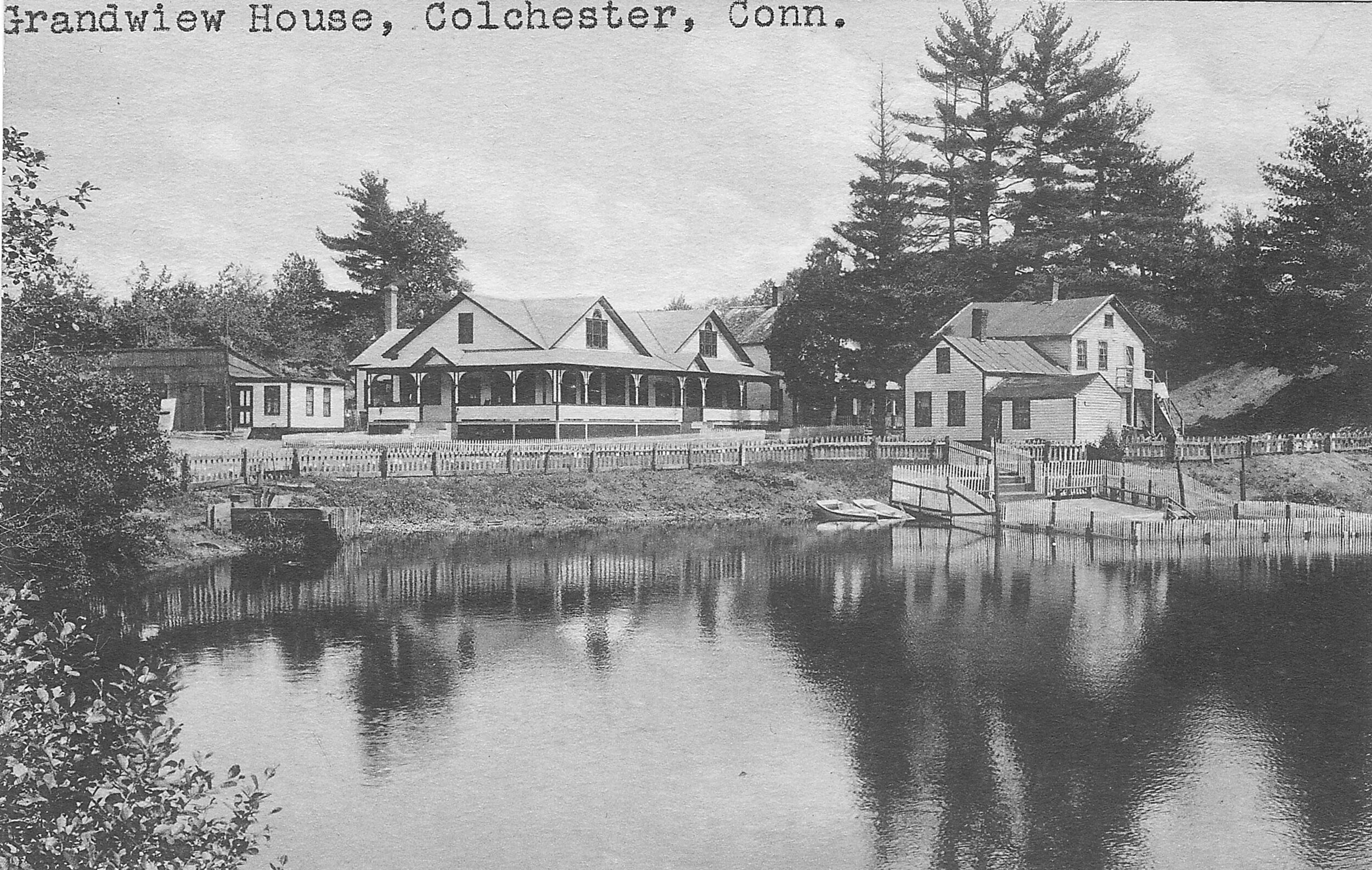Home History
Five Chimneys, Five Owners…
12 Broadway was built by Horace Smith in 1840 on the site and foundation of the 18th century Taintor's Tavern. Horace Smith was a well-to-do farmer who owned many acres of land with his brother, Charles. The house was originally built with large Greek-style columns in front that spanned two floors (pictured below), but before the turn of the century, the facade was altered to its current design which extended the interior front rooms, added bay windows and incorporated a wrap around front porch (pictured above). The Cragin family, from whom the Cragin Memorial Library gets its name, moved here after their family homestead was destroyed by fire. The O'Connell family, who raised five children in the home, owned it next. Annie O'Connell worked here as the town's first telephone switchboard and, with her sister, Margaret, also operated the Lenoco Inn and Tearoom in the house. The Johnston family acquired the house via probate after Annie's passing and ran an antiques store in the back wing. Today the house is again owned by a Smith family, but of no relation to Horace.
Town History
Colchester, “the Catskills of Connecticut”
Photograph of Colchester’s Main Street between 1888-1890, an era with horse-drawn buggies and street-lined elm trees. The Colchester Town Green (still present today) is visible on the left, as well as Merchant’s Row - the row of commercial buildings on the right, with the Colchester Congregational Church peeking between trees in the distance.
Colchester was incorporated in 1698 as a typical New England farming community. During the Revolutionary War, Connecticut got the nickname, “the Provision State,” because it provided supplies and food to the Continental army in larger proportion to its size than other states. In Colchester, state commissary Col. Henry Champion was one of the primary contributors to this effort.
By 1800, Colchester was quite prosperous, with Pierpoint and Abigail Bacon being among the town’s wealthiest residents. They both died in 1800, and in Pierpoint’s will, he bequeathed his entire estate to the town to build a school. This school opened in 1803 and was named Bacon Academy in his honor. The school was unique in the state, as it not only provided what would now be called primary education, but also secondary and college-preparatory education. In essence, Bacon Academy was the state’s first high school.
Another unprecedented aspect of education in Colchester at the time Bacon Academy opened was the creation of the School for Colored Children. One of the special things about this school was that the African American students were taught by African American teachers. In 1842, Bacon Academy began to admit females to its higher education branches, and in 1848, the school was racially integrated more than a century before Brown v. Board of Education led to the official end of segregation across the rest of the United States.
In the first half of the 20th century, the hotel and resort business- owned mostly by and catering to Jewish people- became particularly important in Colchester. This business was so successful that Colchester acquired the nickname, “the Catskills of Connecticut.” Colchester can also be proud of being the lifelong home of World War II Congressional Medal of Honor winner William J. Johnston, who passed away in 1990. Today, Colchester is again prosperous, and appropriately the town’s motto is, “Where Tradition Meets Tomorrow.”
- from ‘Images of America: Colchester’ by Gary A. Walter
A Full Town History
by the Colchester Historical Society
The Town of Colchester, Connecticut was founded in 1698, at a point just north of the present Town Green, at Jeremiah’s Farm on land purchased by Nathaniel Foote from the Sachem of the Mohegan Indians. Early in the 17th century, Nathaniel Foote’s grandfather emigrated from Colchester, England to America joining a group of early English settlers with a vision to lay out a new plantation in a large tract of virgin wilderness.
Colchester’s early history, like many towns in New England, centered around the church parish and in 1703 the General Court of the Colony of Connecticut ruled that the settlement could organize a church body here known as Colchester. Within a few years, several grist mills and saw mills were built to provide grain and lumber. By 1706, the first street was laid out and was named Town Street. This street was nearly 200 feet wide and is now the southern end of Old Hebron Road. By 1714, there were nearly 50 families in town.
By 1756, Colchester was one of the thriving rural towns in the Colony. Its population was recorded as 2,300 inhabitants and by 1782 grew to be 3,300. Settlers were mostly self-sufficient. One of the first textile mills in America began operation in 1780 in Westchester. Other early industries were iron works, clothier shops, potash works, and brick kilns. Industrial expansion in America was evident in Colchester by the 19th century. There were three tanneries and a woolen mill in 1819, a hatter in 1828, a wheel and carriage factory in 1858, a paper mill in 1869, a creamery in 1886, and a canning company in 1893.
Libraries are always important to the intellectual life and social cohesion of any community and Colchester is no exception. The first organized library in Colchester was the Colchester Library Association founded in 1854. The association’s first public reading room was on the second floor of the original Fire Station, still located on South Main Street. The association and its library grew over the following years and by 1886 a much larger facility was needed to hold the collection, so that year they moved into the Worthington Block on Merchants’ Row. Unfortunately the fire of 1890 that destroyed all of Merchants’ Row along with the Colchester Library Association’s facility’s and collections. After the Worthington Block was rebuilt the association moved back in and started rebuilding its library from scratch. Another fire on Merchants’ Row in 1898 did not destroy the Worthington Block or the library in it, but in addition to destroying all of Merchants’ Row to the south, it also destroyed the house of Ardelia Cragin on Linwood Avenue.
Mrs. Cragin was the widow of Dr. Edwin T. Cragin and the mother of Dr. Edwin B. Cragin. After the fire destroyed her house she moved to another location and her house site was left empty. In 1903 Dr. Cragin announced that he was donating the site and sufficient funds to the Town of Colchester to build a new dedicated library building and to stock it with materials. The new building, named the Cragin Memorial Library after Dr Cragin’s late father opened in 1905 and has been serving the town ever since. In the 1960s an addition to the building was added enlarging it to the library we know today.
During this industrial heyday, the Hayward Rubber Company was established in 1847. Nathaniel Hayward along with Charles Goodyear had discovered the process of vulcanized rubber. It is said the Hayward was the true inventor and that Goodyear provided the cash to fund his experiments. Hayward founded his new company in Colchester and from here rubber products, boots, and shoes were shipped all over the country. The company thrived until 1893 when it was closed and later burned to the ground.
Industrial expansion prompted a demand for labor, leading to population growth. The town prospered. New homes and sidewalks were built, a park was laid out, and the streets were lighted with gas lanterns.
Transportation during this period included the railroad. In 1875 the link between Willimantic and Middletown on the Boston to New York line was completed. The section ran through North Westchester and over the Lyman Viaduct to the west. In 1876, the town appropriated $25,000 to lay track between Colchester and Amston. Both freight and passengers were carried over this track for nearly 80 years.
By 1900 farming had diminished and the rubber mill closed, but this was a time for another new beginning for Colchester. The Baron De Hirsch Foundation of New York had discovered that Colchester was an excellent place for the resettlement of European Jewish immigrants. By 1923, there were about 750 children recorded in the school census out of a total town population of 2,100. Since farming was no longer prosperous, many of the immigrants began to supplement their livelihoods by taking on boarders in the summer from nearby sweltering cities, particularly New York City.
Within the span of a few years, Colchester became the 20th century’s “Catskills of Connecticut.” At least seven major hotels thrived including the Broadway House, owned by Abraham and Rose Jaffe, Harris Cohen’s Fairview House, Julius Sultan’s Hilltop Lodge, Schwartz’s, Kessler’s, Horowitz’s, and Barnett Dember’s. The tourist industry boomed throughout the 1930s.
Postwar growth in neighboring towns led to a new era for Colchester. A new generation of suburban dwellers found Colchester to be an excellent “bedroom” community due to an improved highway system and its proximity to Hartford, Middletown and the Norwich/New London areas. During the 1950s the beach traffic brought many through the center of Colchester to frequent their favorite stops including Harry’s, the Colchester Bakery and Levine and Levine Coat Factory. The Route 2 bypass of the town was completed in the 1968, but for those who did not pass through, Colchester’s dedication to the public school system, its diverse population and its quality of life increased its population to 7,761 by 1980. Today, over 300 years after the settling of Colchester, the population has grown to over 16,000.










